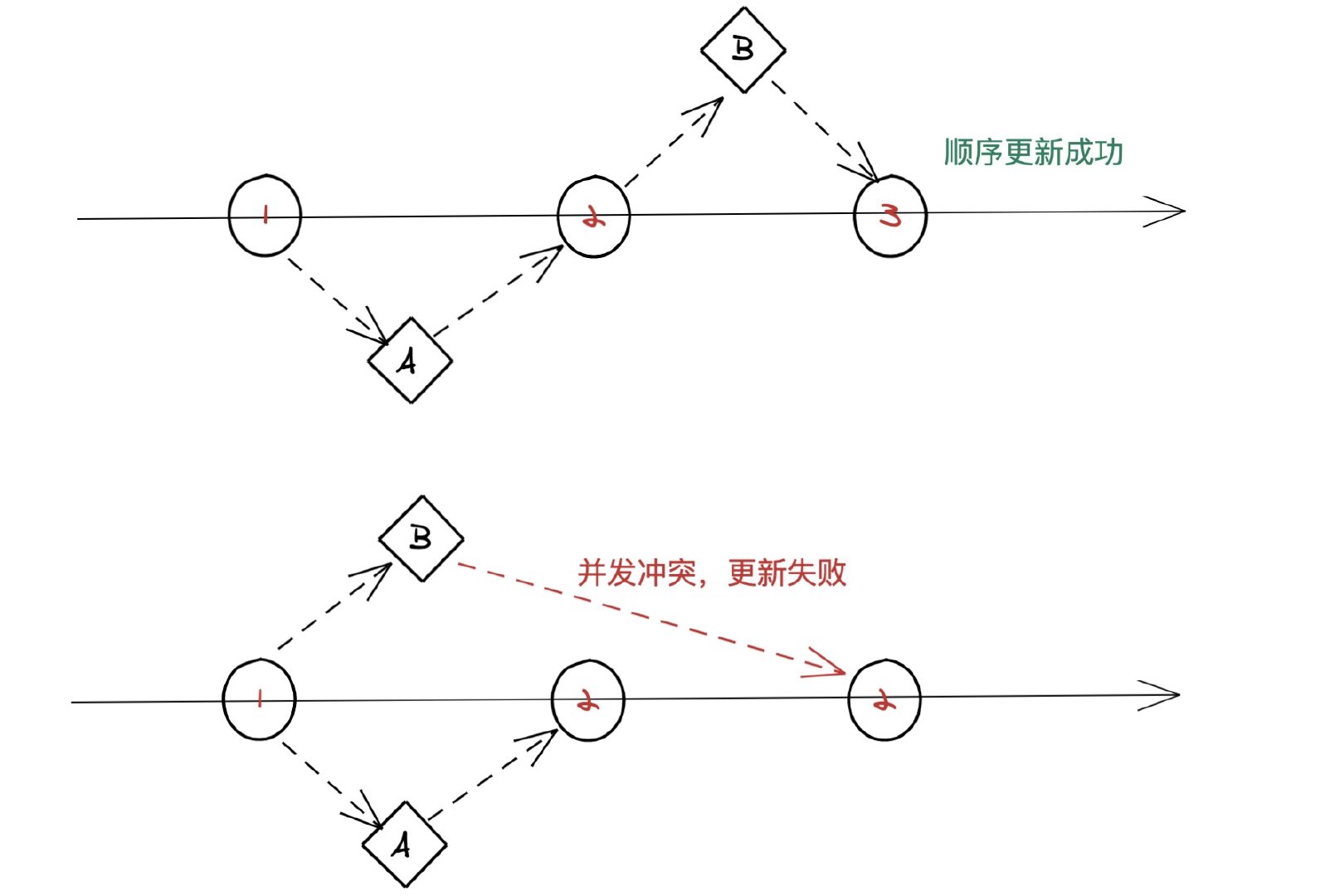
前言
最近在用 Go 写业务的时碰到了并发更新数据的场景,由于该业务并发度不高,只是为了防止出现并发时数据异常。
所以自然就想到了乐观锁的解决方案。
实现
乐观锁的实现比较简单,相信大部分有数据库使用经验的都能想到。
1
| UPDATE `table` SET `amount`=100,`version`=version+1 WHERE `version` = 1 AND `id` = 1
|
需要在表中新增一个类似于 version 的字段,本质上我们只是执行这段 SQL,在更新时比较当前版本与数据库版本是否一致。

如上图所示:版本一致则更新成功,并且将版本号+1;如果不一致则认为出现并发冲突,更新失败。
这时可以直接返回失败,让业务重试;当然也可以再次获取最新数据进行更新尝试。
我们使用的是 gorm 这个 orm 库,不过我查阅了官方文档却没有发现乐观锁相关的支持,看样子后续也不打算提供实现。

不过借助 gorm 实现也很简单:
1
2
3
4
5
6
7
8
9
10
11
12
13
14
15
16
17
18
| type Optimistic struct {
Id int64 `gorm:"column:id;primary_key;AUTO_INCREMENT" json:"id"`
UserId string `gorm:"column:user_id;default:0;NOT NULL" json:"user_id"`
Amount float32 `gorm:"column:amount;NOT NULL" json:"amount"`
Version int64 `gorm:"column:version;default:0;NOT NULL" json:"version"`
}
func TestUpdate(t *testing.T) {
dsn := "root:abc123@/test?charset=utf8&parseTime=True&loc=Local"
db, err := gorm.Open(mysql.Open(dsn), &gorm.Config{})
var out Optimistic
db.First(&out, Optimistic{Id: 1})
out.Amount = out.Amount + 10
column := db.Model(&out).Where("id", out.Id).Where("version", out.Version).
UpdateColumn("amount", out.Amount).
UpdateColumn("version", gorm.Expr("version+1"))
fmt.Printf("#######update %v line \n", column.RowsAffected)
}
|
这里我们创建了一张 t_optimistic 表用于测试,生成的 SQL 也满足乐观锁的要求。
不过考虑到这类业务的通用性,每次需要乐观锁更新时都需要这样硬编码并不太合适。对于业务来说其实 version 是多少压根不需要关心,只要能满足并发更新时的准确性即可。
因此我做了一个封装,最终使用如下:
1
2
3
4
5
6
7
|
var out Optimistic
db.First(&out, Optimistic{Id: 1})
out.Amount = out.Amount + 10
if err = UpdateWithOptimistic(db, &out, nil, 0, 0); err != nil {
fmt.Printf("%+v \n", err)
}
|
- 这里的使用场景是每次更新时将
amount 金额加上 10。
这样只会更新一次,如果更新失败会返回一个异常。
当然也支持更新失败时执行一个回调函数,在该函数中实现对应的业务逻辑,同时会使用该业务逻辑尝试更新 N 次。
1
2
3
4
5
6
7
8
9
10
11
12
13
14
15
16
17
18
19
20
21
| func BenchmarkUpdateWithOptimistic(b *testing.B) {
dsn := "root:abc123@/test?charset=utf8&parseTime=True&loc=Local"
db, err := gorm.Open(mysql.Open(dsn), &gorm.Config{})
if err != nil {
fmt.Println(err)
return
}
b.RunParallel(func(pb *testing.PB) {
var out Optimistic
db.First(&out, Optimistic{Id: 1})
out.Amount = out.Amount + 10
err = UpdateWithOptimistic(db, &out, func(model Lock) Lock {
bizModel := model.(*Optimistic)
bizModel.Amount = bizModel.Amount + 10
return bizModel
}, 3, 0)
if err != nil {
fmt.Printf("%+v \n", err)
}
})
}
|
以上代码的目的是:
将 amount 金额 +10,失败时再次依然将金额+10,尝试更新 3 次;经过上述的并行测试,最终查看数据库确认数据并没有发生错误。
面向接口编程
下面来看看具体是如何实现的;其实真正核心的代码也比较少:
1
2
3
4
5
6
7
8
9
10
11
12
13
14
15
16
17
18
19
20
21
22
23
24
| func UpdateWithOptimistic(db *gorm.DB, model Lock, callBack func(model Lock) Lock, retryCount, currentRetryCount int32) (err error) {
if currentRetryCount > retryCount {
return errors.WithStack(NewOptimisticError("Maximum number of retries exceeded:" + strconv.Itoa(int(retryCount))))
}
currentVersion := model.GetVersion()
model.SetVersion(currentVersion + 1)
column := db.Model(model).Where("version", currentVersion).UpdateColumns(model)
affected := column.RowsAffected
if affected == 0 {
if callBack == nil && retryCount == 0 {
return errors.WithStack(NewOptimisticError("Concurrent optimistic update error"))
}
time.Sleep(100 * time.Millisecond)
db.First(model)
bizModel := callBack(model)
currentRetryCount++
err := UpdateWithOptimistic(db, bizModel, callBack, retryCount, currentRetryCount)
if err != nil {
return err
}
}
return column.Error
}
|
具体步骤如下:
- 判断重试次数是否达到上限。
- 获取当前更新对象的版本号,将当前版本号 +1。
- 根据版本号条件执行更新语句。
- 更新成功直接返回。
- 更新失败
affected == 0 时,执行重试逻辑。
- 重新查询该对象的最新数据,目的是获取最新版本号。
- 执行回调函数。
- 从回调函数中拿到最新的业务数据。
- 递归调用自己执行更新,直到重试次数达到上限。
这里有几个地方值得说一下;由于 Go 目前还不支持泛型,所以我们如果想要获取 struct 中的 version 字段只能通过反射。
考虑到反射的性能损耗以及代码的可读性,有没有更”优雅“的实现方式呢?
于是我定义了一个 interface:
1
2
3
4
| type Lock interface {
SetVersion(version int64)
GetVersion() int64
}
|
其中只有两个方法,目的则是获取 struct 中的 version 字段;所以每个需要乐观锁的 struct 都得实现该接口,类似于这样:
1
2
3
4
5
6
7
| func (o *Optimistic) GetVersion() int64 {
return o.Version
}
func (o *Optimistic) SetVersion(version int64) {
o.Version = version
}
|
这样还带来了一个额外的好处:

一旦该结构体没有实现接口,在乐观锁更新时编译器便会提前报错,如果使用反射只能是在运行期间才能进行校验。
所以这里在接收数据库实体的便可以是 Lock 接口,同时获取和重新设置 version 字段也是非常的方便。
1
2
| currentVersion := model.GetVersion()
model.SetVersion(currentVersion + 1)
|
类型断言
当并发更新失败时affected == 0,便会回调传入进来的回调函数,在回调函数中我们需要实现自己的业务逻辑。
1
2
3
4
5
6
7
8
| err = UpdateWithOptimistic(db, &out, func(model Lock) Lock {
bizModel := model.(*Optimistic)
bizModel.Amount = bizModel.Amount + 10
return bizModel
}, 2, 0)
if err != nil {
fmt.Printf("%+v \n", err)
}
|
但由于回调函数的入参只能知道是一个 Lock 接口,并不清楚具体是哪个 struct,所以在执行业务逻辑之前需要将这个接口转换为具体的 struct。
这其实和 Java 中的父类向子类转型非常类似,必须得是强制类型转换,也就是说运行时可能会出问题。
在 Go 语言中这样的行为被称为类型断言;虽然叫法不同,但目的类似。其语法如下:
1
2
3
| x.(T)
x:表示 interface
T:表示 向下转型的具体 struct
|
所以在回调函数中得根据自己的需要将 interface 转换为自己的 struct,这里得确保是自己所使用的 struct ,因为是强制转换,编译器无法帮你做校验,具体能否转换成功得在运行时才知道。
总结
有需要的朋友可以在这里获取到源码及具体使用方式:
https://github.com/crossoverJie/gorm-optimistic
最近工作中使用了几种不同的编程语言,会发现除了语言自身的语法特性外大部分知识点都是相同的;
比如面向对象、数据库、IO操作等;所以掌握了这些基本知识,学习其他语言自然就能触类旁通了。



